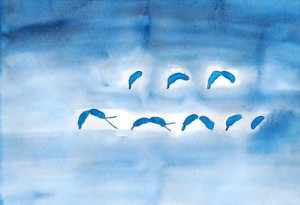
By Morgan Kelly, Office of Communications
Drawing from his engineering background, Princeton University researcher Alexandre Persat had a notion as to why the bacteria Caulobacter crescentus are curved — a hunch that now could lead to a new way of studying the evolution of bacteria, according to research published in the journal Nature Communications.
Commonly used in labs to study cell division, C. crescentus naturally take on a banana-like curve, but they also can undergo a mutation in which they grow to be perfectly straight. The problem was that in a laboratory there was no apparent functional difference between the two shapes. So a question among biologists was, why would nature bother?
Then Persat, who is a postdoctoral researcher in the group of Associate Professor of Molecular Biology Zemer Gitai, considered that the bacteria dwell in large groups attached to surfaces in lakes, ponds and streams. That means that their curvature could be an adaptation that allows C. crescentus to better develop in the water currents the organisms experience in nature.
In the new paper, first author Persat, corresponding author Gitai and Howard Stone, Princeton’s Donald R. Dixon ’69 and Elizabeth W. Dixon Professor of Mechanical and Aerospace Engineering, report that curvature does more than just help C. crescentus hold their ground in moving fluid. The researchers monitored C. crescentus growth on surfaces in flow and found that the bacteria’s arched anatomy is crucial to flourishing as a group.
“It didn’t take a long time to figure out how flow brought out the advantages of curvature,” Persat said. “The obvious thing to me as someone with a fluid-dynamics background was that this shape had something to do with fluid flow.”
The findings emphasize the need to study bacteria in a naturalistic setting, said Gitai, whose group focuses on how bacterial shapes are genetically determined. While a petri dish generally suffices for this line of study, the functionality of bacterial genes and anatomy can be elusive in most lab settings, he said. For instance, he said, 80 percent of the genes in C. crescentus are seemingly disposable — but they might not be in nature.
“We now see there can be benefits to bacterial shapes that are only seen in a growth environment that is close to the bacteria’s natural environment,” Gitai said.
“For C. crescentus, the ecology was telling us there is an advantage to being curved, but nothing we previously did in the lab could detect what that was,” he said. “We need to not only think of the chemical environment of the bacteria — we also need to think of the physical environment. I think of this research as opening a whole new axis of studying bacteria.”
While most bacteria grow and divide as two identical “daughter” cells, C. crescentus divides asymmetrically. A “stalked” mother cell anchors to a bacterium’s home surface while the upper unattached portion forms a new, juvenile version of the stalked cell known as a “swarmer” cell. The swarmer cells later morph into stalked cells then eventually detach before laying down roots nearby. They repeat the life cycle with their own swarmer cell and the bacterial colony grows.
The Princeton researchers found that in moving water, curvature points the swarmer cell toward the surface to which it needs to attach. This ensures that the bacteria’s next generation does not stray too far from its progenitors, as well as from the nutrients that prompted cell division in the first place, Gitai said. On the other hand, the upper cells of straight bacteria — which are comparatively higher from the ground — are more likely to be carried far away as they are to stay near home.
But the advantage of curvature only goes so far. The researchers found that when the water current was too strong, both curved and straight bacteria were pressed flat against the surface, eliminating the curved cells’ colonization advantage.
These findings put some interesting boundaries on what is known about C. crescentus, starting with the upper limits of the current in which the organism can thrive, Gitai said. He and Persat also plan to pursue whether the bacteria are able to straighten out and cast offspring downstream when the home colony faces a decline in available nutrients.
At the same time, understanding why C. crescentus got its curve helps in figuring out the evolution of other bacteria, he said. Close relatives of the bacteria, for example, are not curved — could it have to do with the severity of their natural environment, such as the powerful turbulence of an ocean? Harmful bacteria such as Vibrio cholerae, strains of which cause cholera, are curved, though the reason is unclear. It’s possible this shape could be related to the organism’s environment in a way that might help treat those infected by it, Gitai said.
Whatever the reason for a specific bacteria’s shape, the Princeton research shows that exploring the influence of its natural habitat could be worthwhile, Gitai said.
“It was clear with C. crescentus that we needed to try something different,” Gitai said. “People didn’t really think of flow as a major driver of this bacteria’s evolution. That really is a new idea.”
Persat, Alexandre, Howard A. Stone, Zemer Gitai. 2014. The curved shape of Caulobacter crescentus enhances surface colonization in flow. Nature Communications. Article published online May 8, 2014. DOI: 10.1038/ncomms4824
The work was supported by the Gordon and Betty Moore Foundation (grant no. GBMF 2550.02), the National Science Foundation (grant no. CBET-1234500), and the National Institutes of Health Director’s New Investigator Innovator Award (grant no. 1DP2OD004389).

You must be logged in to post a comment.